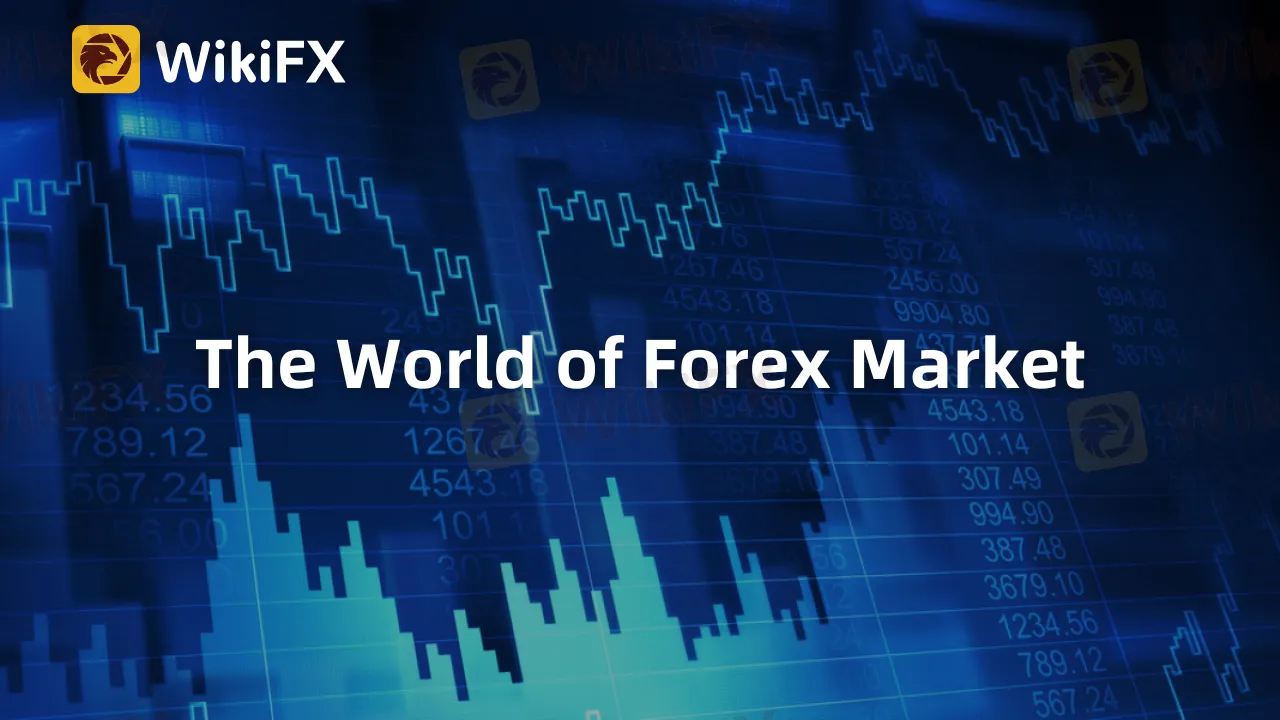简体中文
繁體中文
English
Pусский
日本語
ภาษาไทย
Tiếng Việt
Bahasa Indonesia
Español
हिन्दी
Filippiiniläinen
Français
Deutsch
Português
Türkçe
한국어
العربية
The World of Forex Market
Abstract:The foreign exchange market, with a daily volume of $6.6 trillion, is the largest financial market. It operates 24/7, with major participants including central banks, commercial banks, corporations, and traders. The market involves trading currency pairs using fundamental and technical analysis, different trading strategies, and risk management. Regulatory organizations oversee the market. The future of forex trading is expected to involve algorithmic trading and AI. Psychological discipline is also essential for successful trading.

The foreign exchange market, or FX market, is the world's biggest financial market. A decentralized market is used for global money trading. The Forex market is unique in that trading occurs in major financial cities throughout the world 24 hours a day, seven days a week. The forex market eclipses the stock market and other financial sectors, with a daily volume of $6.6 trillion. US Dollar (USD), Euro (EUR), Japanese Yen (JPY), British Pound (GBP), and Swiss Franc (CHF) are the most often traded currencies.
History of Forex Trading
The roots of forex trading may be traced back to antiquity when traders traded currencies to facilitate trade between various countries. The Bretton Woods Agreement, however, was dissolved in the 1970s, clearing the way for a free-floating exchange rate regime and the genesis of the contemporary forex market. The introduction of automated trading systems in the 1990s resulted in yet another transition in the Forex market, enabling a broader spectrum of individuals to engage.
Forex Market Participants
Central banks, commercial banks, multinational organizations, hedge funds, retail forex brokers, and traders are among the numerous participants in the currency market. Central banks are important players in the foreign exchange market because they may affect currency values via their monetary policies. Commercial banks contribute to the functioning of the currency market by providing liquidity, which enables transactions. The forex market is used by international corporations to hedge against currency risk, while hedge funds utilize it to speculate. Individual traders may access the forex market by utilizing retail forex brokers' trading platforms.
Currency Pairs
Currency pairings are the bedrock of forex trading. They denote the exchange rate between two currencies. Currency pairs are classified as major, minor, or unusual. Dollars are traded in significant currency pairings such as the Euro, Japanese yen, and British pound. These are the most liquid and trade at the highest volumes. Among the less popular currency pairings are USD/CHF, EUR/GBP, and EUR/JPY. Currency pairs from developing economies, such as the USD/ZAR or USD/TRY, are examples of exotic currency pairs.

Forex Market Sessions
Even though the Forex market is open 24 hours a day, trading sessions are often separated into four main ones: Sydney, Tokyo, London, and New York. Each session is unique in terms of liquidity and volatility. Sydney starts at 5 p.m. EST, Tokyo at 7 p.m. EST, London at 3 a.m. EST, and New York at 8 a.m. EST. Liquidity and volatility rise when numerous sessions overlap.
Fundamental Analysis in Forex
Analysis of economic data, monetary policy decisions, political developments, and world events that may affect exchange rates are all part of fundamental analysis. GDP, inflation, and employment data are some of the key economic indicators. Currency rates may also be impacted by central bank policies like interest rate choices and quantitative easing. Geopolitical tensions and political events like elections may cause market volatility.
Technical Analysis in Forex
In order to forecast future price changes, technical analysis entails analyzing charts and using technical indicators. Candlestick charts, bar charts, and line charts are the most commonly used charting techniques. Moving averages, RSI, and MACD are a few examples of technical indicators that are often employed in forex trading.

Trading Strategies in Forex
Forex trading employs a variety of trading strategies, including scalping, swing trading, day trading, and carry trading. Carry trading is the practice of borrowing money at a low-interest rate and investing it at a high-interest rate in order to benefit from the difference in interest rates. Swing trading entails maintaining positions for many days to weeks, as opposed to day trading, which is starting and closing positions in a single day. Scalping is a high-frequency trading technique that entails initiating and closing trades in a matter of seconds or minutes in order to capitalize on minute price changes.
Risk Management in Forex Trading
To reduce possible losses in forex trading, risk management is essential. Implementing a stop loss, a take profit, and position size are all examples of risk management strategies. A take-profit level is where a trade will be terminated to capture gains, while a stop-loss level is where a transaction will be stopped to minimize losses. To reduce risk, position sizing entails figuring out how big a position should be in relation to the account balance.
Forex Trading Platforms
Software programs called forex trading platforms provide users access to the forex market. MetaTrader 4/5, cTrader, and NinjaTrader are a few well-known forex trading platforms. These systems provide a range of features, including automated trading options, technical indicators, and charting tools.

Leverage and Margin Trading in Forex
Trading using leverage and margin enables investors to hold positions that are larger than their account balance. While the margin is the amount of money needed to start a position, leverage enables traders to borrow money from a broker to raise the size of their position. Margin trading and leverage may raise possible gains while also raising potential losses.
Regulation of Forex Markets
Different regulatory organizations in various nations oversee the forex markets. These oversight organizations work to safeguard investors from scams and maintain fair procedures in the forex industry. The Financial Conduct Authority (FCA) in the United Kingdom and the Commodity Futures Trading Commission (CFTC) in the United States are two examples of regulatory agencies.
Future of Forex Trading
New advancements in forex trading are expected to involve the use of algorithmic trading and artificial intelligence (AI). Algorithmic trading refers to the use of computer programs to carry out trades based on established rules. In order to evaluate vast volumes of data and generate predictions based on trends, AI may be employed in the forex market.
Forex Trading Psychology
Successful forex trading depends on having a strong psychological foundation. Successful traders must possess the qualities of discipline, patience, and emotional restraint. Fear and greed are two emotions that might cause hasty trading choices that can lead to big losses.
Case Studies of Successful Forex Traders
Gaining knowledge about successful Forex traders' trading methods and experiences may be really beneficial. For instance, well-known forex trader George Soros famously earned $1 billion by shorting the British pound during the 1992 Black Wednesday crisis. As part of his trading method, he looked at both technical analysis and economic fundamentals to spot market mispricings.
Conclusion
The Forex market requires a thorough understanding of its participants, currency pairs, trading sessions, fundamental and technical analysis, trading strategies, risk management, trading platforms, leverage and margin trading, regulatory bodies, emerging trends, trading psychology, and case studies of successful traders because it is a complicated and dynamic market. The ability to grasp these subjects will help traders succeed in the forex market.
Download and install the WikiFX App on your smartphone to stay updated on the latest news.
Download the App here: https://social1.onelink.me/QgET/px2b7i8n

Disclaimer:
The views in this article only represent the author's personal views, and do not constitute investment advice on this platform. This platform does not guarantee the accuracy, completeness and timeliness of the information in the article, and will not be liable for any loss caused by the use of or reliance on the information in the article.
Read more

WikiFX "3·15 Forex Rights Protection Day" – Official Release of the Blacklist
WikiFX, as a globally leading forex investment ecosystem service platform, has always been committed to providing fair and authoritative broker verification services for forex investors, while offering solid rights protection support for every victim of forex investment. On February 26, 2025, WikiFX once again launched its annual "3·15 Forex Rights Protection Day" event, aiming to empower forex investors to speak out and defend their rights through open, transparent, and robust means.

Nigeria’s Oil and Gas Sector Gains Momentum
Nigeria’s oil and gas industry is experiencing a surge in investment, fueled by policy reforms and international collaboration, paving the way for continued energy expansion.

The Global Tariff War Escalates: Who Suffers the Most?
The global trade war is intensifying as countries continue to raise tariffs, aiming to protect their own economies while creating greater market uncertainty. In this tit-for-tat game, who is truly bearing the brunt?

Immediate Edge Review 2025: Is it safe?
Launched in 2019, Immediate Edge claims to be an automated cryptocurrency trading platform using AI technology for crypto trading services. The platform requires a minimum deposit of $250 to begin trading, which is relatively expensive for many investors. During its short operation, Immediate Edge failed to establish a positive reputation. The platform has undergone frequent domain changes and has repositioned itself as an intermediary connecting users with investment firms—a move that appears designed to obscure its actual operations. Immediate Edge restricts services to investors from the United States; it remains accessible to users in other regions.
WikiFX Broker
Latest News
FINRA Panel Orders Stifel to Pay $132.5M for Misleading Investors
The Future of Trading is Here: How AI is Reshaping the Market Landscape
Nigeria’s Oil and Gas Sector Gains Momentum
How to Avoid Risks from Scam Brokers in Forex Investment
Gold Price Hits Record High Amid Economic Uncertainty and Policy Shifts
Could DeepSeek Be Linked to a $390 Million Fraudulent U.S. Server Deal?
Ripple Secures Dubai License: First Blockchain Payments Provider in DIFC
BSP Restricting Offshore Forex Trades to Control Peso Volatility
Retiree Loses RM2.33 Million in Investment Scam – Could You Be Next?
Will Trump's Trade Policies Fuel Inflation? BlackRock Warns of Economic Risks
Currency Calculator






